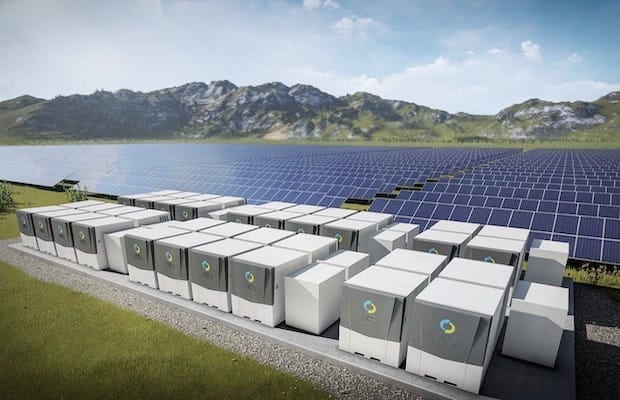The POWER Interview: IRA, Economics Support Solar-Plus-Storage Market
Credit to Author: Darrell Proctor| Date: Thu, 09 Mar 2023 14:52:34 +0000

Several executives in the energy industry have spoken with POWER in recent months about how utility-scale solar power projects benefit from the addition of energy storage. Many have noted how installing storage systems alongside solar arrays supports the integration of renewable energy to the power grid, and also enhances the economic potential of any such project.
Mike Toomey, director of storage development at Denver, Colorado-based Redeux Energy, a utility-scale solar and storage development company, provided POWER with insight about his group’s objectives. Redeux works on greenfield and brownfield projects, helping developers with land acquisition, project engineering, interconnection, permitting, power offtake, financing, and community engagement. Toomey has more than 14 years of experience in the renewable energy industry, including seven in energy storage development, origination, policy, strategy, and construction.

Toomey has worked directly and contributed to NextEra Energy Resources, Recurrent Energy, and Tesla, starting utility-scale energy storage development in the U.S. both as standalone and integrated solar photovoltaic (PV)-plus-storage projects. Toomey also has served on the board of the California Energy Storage Alliance and Interwest Alliance to promote the adoption of storage and renewables throughout the western U.S.
Toomey in his role at Redeux is responsible for the go-to-market strategy for storage applications and development of standalone storage projects in target markets. He works with Redeux’s development team to guide the energy storage elements of solar photovoltaic-plus-storage projects throughout the U.S.
POWER: What are the major trends you’re seeing in the solar-plus-storage market?
Toomey: One major trend is the shift away from DC-tied solar-plus-storage to predominantly AC-tied. This is due to multiple reasons, but the biggest factor is the passing of the IRA (Inflation Reduction Act) allowing for storage to participate in the market directly without the previous charging restrictions for tax credit eligibility. The additional benefits of a near-fully flexible storage system collocated with solar outweigh the capture of clipped solar generation. This trend will also be recognizable as the size of storage co-located with solar increases proportional to the solar project, up to and exceeding 100% of solar nameplate. This not only maximizes the existing interconnection, but also provides greater downside protection from economic curtailment of the solar facility.
POWER: Will there be growth in solar-plus-storage outside of utility-scale projects (i.e., residential or commercial/industrial applications)?
Toomey: Yes, with the extension of tax credits for solar, we expect to see more deployments in the distributed space. As market rates dictate, solar will create a mini “duck curve” for the individual system owner, adding justification to add storage to mitigate the demand charges that are now a shorter, more predictable period in the day.
POWER: Are there battery technologies that will be used as a replacement for (or alternative to) lithium-ion?
Toomey: As the need for duration extends beyond four hours into six to eight hours, we expect to see more applications of alternative storage technologies ranging from flow, compressed air and non-lithium BESS (battery energy storage system) technologies like zinc-air. However, demand from utilities and markets have not brought these technologies to the forefront. Despite some companies proving their technology in commercial applications, deployments remain largely in the “pilot” stage. We expect that trend to continue into 2023, with only a handful of projects seeing contracting success in relatively small size applications.
POWER: How important is adding storage to a solar (or other renewable energy) project when it comes to grid integration and ancillary services?
Toomey: Unless integration charges are specifically attributed to a project, integration will not be a primary driver. However, storage is a constraint mitigant. If there are economic or physical reasons that power cannot be transmitted from solar generation, storage will improve reliability and maximize production of the existing equipment. Projects without storage will be at risk of future curtailment as the push for more renewables saturates markets. As an investor or developer, storage can be viewed as allowing an additional solar project to be “integrated” into an otherwise unfriendly (read: congested) solar environment.
In every wholesale market in the U.S., the ancillary service market is a fraction of the generation needs and will be saturated in the coming couple of years. However, storage will continue to be added at renewable generation facilities for the reasons outlined above.
POWER: What are the cost advantages to having storage adjacent to a solar farm, as opposed to a standalone storage system?
Toomey: The largest savings by co-locating storage with a solar farm comes in the form of shared development and equipment costs. A standalone storage project would need to go through separate permitting, interconnection filings, and in many cases a costly transformer. By incorporating with solar, the cost of storage is reduced to land, which is largely de minimis compared to the land requirements of solar, and the equipment costs up to and including medium voltage.
Savings are also realized in the form of marginal cost of renewable energy. As curtailment risk increases, every additional solar project that enters operations will become less efficient than the last, increasing the cost to produce each MWh. This benefit can be realized through standalone storage systems, but they would need to be located in an area unconstrained from receiving solar generation. Given the risk of reduction already noted, we expect investments in solar to not leave such a scenario up to chance and incorporate storage directly at the site, leaving nothing to chance.
As utilities continue to get more comfortable with energy storage on their systems, we are seeing an expansion of acceptable applications. Storage is now being considered an option to mitigate transmission and distribution upgrades. As that trend evolves, we may even see scenarios where solar is co-located with storage transmission assets to avoid the need to charge from the grid under more extreme constraint scenarios.
For any or all of the above to come to fruition, policy will play a critical role. Storage policy is slowly catching up with storage development and can often play a role in limiting storage markets. Policymakers and utilities recognize the value of storage but are often constrained by legacy policy designed for generation and reliability. More storage will be needed as we increase solar and wind on all systems–storage policy will be an area where markets will either constrain or accelerate storage development.
—Darrell Proctor is a senior associate editor for POWER (@POWERmagazine).
The post The POWER Interview: IRA, Economics Support Solar-Plus-Storage Market appeared first on POWER Magazine.